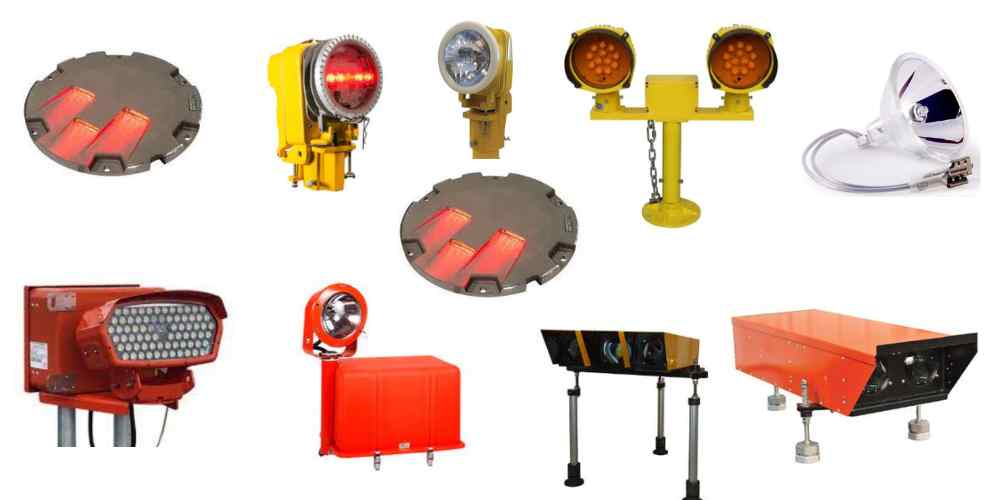Airfield Ground Lighting Runway and Taxiway in USA
As the aviation industry continues to evolve, the importance of efficient and reliable airfield ground lighting (AGL) systems cannot be overstated. These systems play a critical role in enhancing airport safety, improving visibility for pilots, and facilitating smooth operations during low-light conditions. In this comprehensive guide, we will delve into various aspects of airfield ground lighting, focusing on runway and taxiway lighting systems in the United States in 2024.

Airfield Ground Lighting (AGL) Systems
Airfield ground lighting, also known as aeronautical ground lighting, encompasses a variety of lighting fixtures strategically installed across airport runways, taxiways, and other critical areas. These lighting systems serve multiple purposes, including guiding pilots during takeoff, landing, and taxiing, as well as enhancing visibility in adverse weather conditions.
Key Components of AGL Systems
- Runway Edge Lights: These lights are positioned along the edges of runways to outline the runway’s boundaries and aid pilots in maintaining the correct alignment during takeoff and landing.
- Taxiway Centerline Lights: Taxiway centerline lights provide visual guidance to pilots, indicating the centerline of taxiways and assisting aircraft in navigating safely between runways, terminals, and other airport facilities.
- Precision Approach Lighting (PAL) Systems: PAL systems consist of a series of lights arranged to provide visual cues to pilots during approach and landing, ensuring a smooth descent and alignment with the runway.
- Runway End Identifier Lights (REILs): REILs are flashing lights installed at the ends of runways to help pilots identify the approach path, especially during low-visibility conditions.
- Constant Current Regulators (CCRs): CCRs are essential components of airfield lighting systems, ensuring a consistent and stable supply of electrical current to the lighting fixtures, thereby optimizing their performance and longevity.
Advancements in AGL Technology
In recent years, there has been a significant shift towards the adoption of light-emitting diode (LED) technology in airfield lighting applications. LED runway lights offer several advantages over traditional incandescent or halogen lights, including higher energy efficiency, longer lifespan, and enhanced brightness and visibility.
Moreover, the integration of solar-powered airfield lighting systems has gained traction, particularly in remote or off-grid locations where access to conventional power sources may be limited. These systems harness solar energy to illuminate runways and taxiways, reducing both operating costs and environmental impact.
Regulatory Standards and Compliance
The International Civil Aviation Organization (ICAO) sets forth standards and recommended practices for airfield lighting systems to ensure uniformity and safety across international airports. In the United States, the Federal Aviation Administration (FAA) oversees the regulatory compliance and certification of airfield lighting installations through rigorous testing and inspection protocols.
Importance of AGL Design and Installation
Efficient design and meticulous installation are paramount to the effectiveness and reliability of airfield ground lighting systems. Airport authorities and lighting engineers collaborate closely to develop lighting layouts that optimize visibility, minimize glare, and adhere to regulatory requirements.
Factors Influencing AGL Design
- Runway Configuration: The layout and orientation of runways influence the placement and configuration of runway edge lights, centerline lights, and other lighting fixtures.
- Traffic Volume: Airports with high traffic volume may require more sophisticated lighting systems to accommodate the increased aircraft movements and ensure operational efficiency.
- Environmental Conditions: Factors such as fog, snow, and low visibility necessitate the incorporation of robust lighting solutions to maintain safe operations during adverse weather conditions.
Maintenance, Repair, and Retrofitting of AGL Systems
Regular maintenance and prompt repairs are essential to preserving the functionality and reliability of airfield ground lighting systems. Airport authorities implement proactive maintenance schedules and conduct routine inspections to identify and address any issues or malfunctions promptly.
Retrofitting and Modernization Initiatives
With advancements in lighting technology and evolving regulatory requirements, many airports in the United States are undertaking retrofitting and modernization projects to upgrade their existing AGL systems. These initiatives aim to enhance visibility, reduce energy consumption, and align with sustainability goals while ensuring compliance with industry standards.
Future Trends and Innovations in AGL Systems
Looking ahead, the future of airfield ground lighting is poised for further innovation and technological advancement. Key trends shaping the landscape of AGL systems include:
- Smart Lighting Solutions: Integration of sensor-based technologies and automation to optimize energy usage and enhance operational efficiency.
- Augmented Reality (AR) Guidance: Development of AR-enabled cockpit displays to provide real-time visual guidance to pilots during taxiing and runway operations.
- Drone-Assisted Maintenance: Utilization of drones for aerial inspections and maintenance of AGL infrastructure, enabling faster and more cost-effective asset management.
- Dynamic Lighting Control: Implementation of dynamic lighting control systems that adjust brightness and color temperature based on environmental conditions and aircraft movements.
The Future of AGL
In conclusion, airfield ground lighting plays a crucial role in ensuring the safety and efficiency of airport operations, particularly during low-light conditions or adverse weather. By embracing technological innovations, adhering to regulatory standards, and investing in modernization initiatives, airports in the United States can enhance visibility, streamline operations, and uphold the highest standards of safety and compliance in 2024 and beyond.
Whether it’s LED runway lights, precision approach lighting systems, or innovative control solutions, the evolution of airfield ground lighting continues to pave the way for safer and more efficient air travel experiences for passengers and crew alike.
FAQs
What are the benefits of LED runway lights over traditional lighting systems?
LED runway lights offer higher energy efficiency, longer lifespan, and enhanced brightness, improving visibility for pilots and reducing maintenance costs over time.
How does airfield ground lighting enhance airport safety?
Airfield ground lighting systems provide visual guidance to pilots during takeoff, landing, and taxiing, reducing the risk of runway incursions and ensuring safe operations in low-light conditions.
Are solar-powered airfield lighting systems suitable for all airports?
Solar-powered airfield lighting systems are suitable for remote or off-grid airports where access to conventional power sources may be limited. However, their feasibility depends on factors such as sunlight exposure and energy requirements.